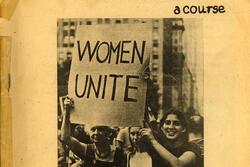We Can't Go Back to "Normal"
In North Carolina, the air is warm and buzzing with life. It’s summer, and there’s a renewed sense of hope and excitement for what lies ahead. Venues are open for indoor seating, and more and more people are proudly sporting "I'm Vaccinated!" stickers. For the first time in over a year, it seems like the future is actually, truly brighter, with a light at the end of this long, dark, terrifying tunnel. We are encouraged to lace up our shoes, straighten up, and look ahead with smiles and laughter, because "things are getting back to normal." The pandemic is coming to an end! Aren't you excited?
I am filled with rage.
How can we “return to normal” in a world that has lost more than three million people? How can we “return to normal” when the wounds from our losses are still gaping, but we haven’t even received stitchings or dressings? How can we “return to normal” when the last year violently exposed the horrific injustices that our “normal” society is built on?
For many of us, surviving the past year was barely manageable. Our nights were sleepless, our days blurred together in whirlwinds of chaos and fear, and our courage hung by a thread. We stayed up with sick patients and relatives. We scrubbed and sanitized and suspended our dreams and routines. We watched in horror as our counties turned red, as emergency rooms overflowed, and as “Baruch Dayan Ha-Emet,” the Jewish blessing on death, became an almost everyday subject line in our emails.
It is overwhelming to try to fully comprehend the enormity of this pandemic. In the United States, almost 600,000 people have died—more than the total number of American deaths during WWII. Millions more caught the virus, which we have yet to fully understand, and many are dealing with long term side effects. Over half a million parents, neighbors, colleagues, and friends are gone, and we have not been able to take the proper time to sit still with our grief. We had patients and children and grandparents to take care of. We were essential health, food, postal, education, and sanitation workers—we could not lock our doors and stay safely behind them. If we were able to, we struggled with isolation and the anxiety, frustration, and loneliness it incurred. We had to stay vigilant, to keep ourselves and our families safe, even as public health mandates were ignored or protested.
Everything about our day-to-day lives was turned upside down. When our loved ones were ill, we couldn’t comfort them in person, or attend normal funeral services when they died. My grandfather z”l passed away last December, and we couldn’t even travel to tell him goodbye. We said our last words over the phone. He did not die of coronavirus, but the virus stole our chance to see him.
Early on in the pandemic, Covid-19 dominated news coverage, and updated reports on positive cases and deaths broadcasted daily. Now, as discussions turn to how we can make everything as it once was, the nonstop horror show of rising deaths and infection rates seems to have fallen by the wayside in favor of grand reopenings and celebrity post-pandemic break-ups. How can we “return to normal” when people are still getting sick, and still dying, and not even breaking headlines? Have we even gotten a chance to mourn those in headlines past?
What’s more, statistics on positive cases or deaths don’t even reflect the full human toll of the pandemic. Since Covid-19 began, almost ten million people have lost their jobs, which is a traumatic experience even without a globally spreading virus. Countless precious gatherings were postponed indefinitely or cancelled. We can never regain the time we lost with loved ones. We can not measure the loss of knowledge that occurs when our elders pass on. Indigneous communities, underserved and oppressed by American political systems, are dealing with the immeasurable loss of fluent language speakers and storytellers. Many people have lost their sense of safety and confidence as this disaster has revealed just how fragile our social systems are.
As the pandemic surged, existing humanitarian crises only worsened. The violence of the world raged on while we struggled against an invisible enemy of disease. White supremacy and colonization continued. Police brutality continued. Immigrant “detention centers” continued. Food insecurity and healthcare inequity continued. Legislative assaults on voting rights, accessibility rights, trans rights, and reproductive rights continued. Abuse and exploitation of our natural environments continued. This is our everyday, expected violence. “Normal” violence. These are the defining elements of the “normal” we’re supposed to yearn for—the pre-pandemic status quo of glossing over injustice that has been accepted. This “normalcy” is built on oppression and violence, not just in America, but all over the world.
This is not to say nothing good came from the pandemic. For brief moments, we saw glimpses of what a better and more inclusive world could look like. Before the pandemic, disabled folks fought for online learning and remote working options, only to be told it was “impossible” or “too expensive”; when Covid descended, we saw a rapid shift toward accessibility with remote learning and work options. However, the focus on “productivity” and “going back to the way things were before” is threatening even those small gains as many companies and schools force workers and students back to in-person settings.
Even if it’s possible to return to our previous version of “normal,” I don’t want to. We must not be comfortable returning to a baseline of injustice. In Judaism, tikkun olam describes our duty to make the world a better place. We are instructed to be discontent with injustice. We are commanded to build a more inclusive world, to fight for the oppressed, and to challenge systems of inequality. We should always be striving for ways to improve the lives of those around us. Because of this, we must demand better of our “normal.” We must acknowledge our collective trauma, grieve, and let our anger fuel us to fight for justice.
While we seem to be turning a corner in the battle against an ongoing pandemic, we cannot simply say “everything is fine” and bury what has happened to us and the inequities that Covid laid bare. It is a blessing to be full of hope and excitement for the future, but it is okay to be angry, too. Let us use our rage to fight for a better world.







